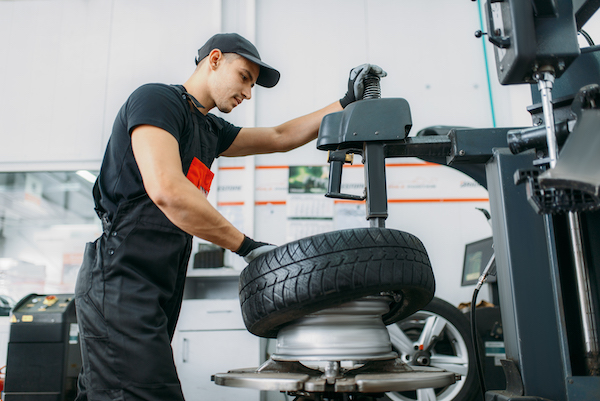Save Big with Mopar Tire Service Specials: Finest Bargains and Expert Treatment
Save Big with Mopar Tire Service Specials: Finest Bargains and Expert Treatment
Blog Article
Tire Solution: The Effect of Weather
When it comes to ensuring ideal efficiency and safety when traveling, comprehending the impact of climate condition on tire service is important. From scorching warmth to icy roadways, each weather condition component can considerably influence tire capability and general driving experience. By diving into the impacts of varying climate problems on tires, drivers can get useful understandings that may improve their car's performance and longevity. In this discussion, we will certainly discover the detailed partnership in between weather and tire service, clarifying the relevance of weather-specific tire maintenance techniques and factors to consider.
Warmth and Tire Efficiency
When exposed to heats, tires experience adjustments in efficiency that can dramatically affect automobile safety and security and handling. The warm created from extended driving or hot climate problems causes the tire rubber to soften, causing minimized tread life and increased wear. As the rubber becomes softer, the tire's hold when traveling reduces, influencing braking distances and overall grip. In severe situations, too much heat can also trigger tire blowouts, posing an extreme safety danger to the car and its residents.
Furthermore, high temperatures can increase the process of tire aging, creating the rubber to wear away a lot more promptly. To mitigate the impacts of warmth on tire efficiency, vehicle drivers need to routinely inspect their tire pressure, turn tires to ensure also wear, and inspect for any kind of signs of damages.
Winter Results
Cold weather problems can have a significant effect on tire performance and safety and security. In chilly weather condition, tires might likewise shed air pressure a lot more quickly, which can impact managing and gas efficiency.
To minimize the results of winter on tires, it is important to routinely check tire stress and inflate them to the supplier's advised levels. Utilizing winter or all-season tires created for winter problems can additionally enhance grip and hold on icy or snowy roadways - mopar tire service specials. Proper tire upkeep, consisting of regular evaluations for wear and damage, becomes a lot more crucial throughout chillier months to guarantee optimal performance and safety
Rainy Conditions Impact
Tires with damaged footsteps are more vulnerable to hydroplaning, where a layer of water builds up in between the road and the tire surface area, leading to loss of traction. To battle this, motorists ought to frequently examine their tires for sufficient tread deepness and consider investing in tires especially developed for wet conditions.

Snow and Tire Safety And Security
Snow-covered roads posture one-of-a-kind difficulties for chauffeurs, emphasizing the importance of correct tire option and maintenance. When driving in snowy conditions, having the ideal tires can make a considerable distinction in safety and performance. Winter months tires are made with unique rubber substances and tread patterns to provide much better grip on snow and ice compared to all-season tires. The deeper footsteps and sipes of winter tires help grasp the road better, reducing the risk of slipping and gliding.
Along with using winter tires, it is critical to guarantee they are appropriately blown up. Winter can cause tire pressure to go down, affecting grip and handling (morris tire and alignment). Routinely checking and preserving the proper tire pressure is vital for optimal performance in snowy conditions

Weather-Related Tire Upkeep
When confronted with numerous climate condition, appropriate tire upkeep comes to be a crucial facet of automobile safety and security and performance. Weather-related tire upkeep encompasses a series of practices focused on making sure optimum tire function and longevity in various weather condition scenarios. One vital element of weather-related tire maintenance is tire pressure law. Varying temperature levels can create tire pressure to differ, impacting traction and gas efficiency. Frequently inspecting and adjusting tire stress according to manufacturer suggestions is crucial for risk-free driving in altering climate conditions. Furthermore, tire walk deepness plays a substantial duty in visit homepage managing various weather elements. Tires with ample walk depth provide better grip on damp or icy roadways, reducing the danger of hydroplaning or skidding. When tread wear gets to a certain deepness is important for maintaining traction and stability in negative weather condition, checking tire tread consistently and replacing tires. By prioritizing weather-related tire maintenance, chauffeurs can enhance safety and security, boost lorry performance, and prolong the life expectancy of their tires.
Verdict
Finally, weather have a substantial effect on tire efficiency and safety. From warm affecting tire stress and put on to cool weather condition minimizing grip, it is vital to think about the climate when keeping and using tires. Stormy problems can lower grasp and result Click This Link in hydroplaning, while snow can boost the threat of mishaps if tires are not appropriately geared up. Weather-related tire upkeep is vital in making sure optimal efficiency and safety when driving.
In this discussion, we will check out the complex connection between weather condition problems and tire solution, dropping light on the relevance of weather-specific tire maintenance methods and factors to consider.

Report this page